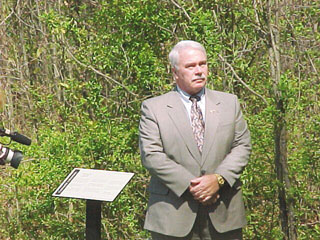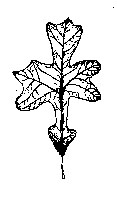
Howard County Arboreta
Centennial Park
- Wilde Lake
- Jackson Pond
- Howard County
Office Complex - Guilford Park
- Centennial Park
- Harwood Park
- Lake Elkhorn
- Howard Community College
- Robinson Nature Center
Forestry Homepage

In cooperation with the Howard County Department of Recreation
and Parks, the Forestry Board formally opened the Centennial
Park Arboretum.
On Friday, 26 April 2001, a bright and sunny morning,
a goodly crowd gathered to witness the opening of the
Arboretum, and to take part in the ceremonies.
County Executive Jim Robey presided and announced
the official opening.
History
Centennial park was planned in 1965 as a reservoir for flood protection. The original lake was created as a flood control measure as part of the regional storm water management system.
The design for the park was completed in 1976 and by 1978 the major parcels of land were acquired. Construction began in the eighties, and the final park was dedicated on June 13, 1987.
Centennial park contains 325 acres with a central lake of 50 acres. Over four miles of paved pathways are maintained, along with nine paved pavilions, tennis and basketball facilities, a boat ramp and dock. The lake is stocked with Largemouth Bass, Bluegill, and Sunfish annually.
In 1989 the park received the 1989 Merit Award for Innovative Design from the American Society of Landscape Architects. In that same year it received the 1989 Excellence on the Waterfront Award from the Waterfront Center.
Maintained by the Howard County Department of Recreation and Parks, the park is open from dawn to dusk, and is a popular site in Howard County for strolling, walking, cycling and skating. Its recreation facilities are in great demand, and it is a prime site for picnics and other gatherings throughout the year.
Trees at Centennial Lake
In addition to providing lakeside recreational opportunities, Centennial Lake has a fine collection of both native and exotic trees and shrubs. Each tree below is linked to its ArborTag which describes the distinguishing features of the species. Those pages can be used to make your own laminated tree tags.
| American Beech | Fagus americana |
| Amur Corktree | Phellodendron amurense |
| Autumn Olive | Elaeagnus umbellata |
| Basswood | Tilia americana |
| Bay Magnolia | Magnolia virginiana |
| Black Cherry | Prunus serotina |
| Black Locust | Robina pseudoacacia |
| Black Oak | Quercus velutina |
| Black Walnut | Juglans nigra |
| Black Willow | Salix nigra |
| Blackgum | Nyssa silvatica |
| Boxelder | Acer negundo |
| Crabapple | Malus coronaria |
| Colorado Spruce | Picea pungens |
| Dogwood | Cornus florida |
| Flowering Cherry | Prunus serrulata |
| Gray Birch | Betula populifolia |
| Green Ash | Fraxinus pennsylvanica |
| Hemlock | Tsuga canadensis |
| Honey Locust | Gleditsia triacanthos |
| Hornbeam | Carpinus caroliniana |
| Kousa Dogwood | Cornus kousa |
| London Planetree | Platanus x acerifolia |
| Mimosa | Albizia julibrissin |
| Osage Orange | Maclura pomifera |
| Persimmon | Diospyros virginiana |
| Pignut Hickory | Carya glabra |
| Pin Oak | Quercus palustris |
| Redbud | Cercis canadensis |
| Red Maple | Acer rubrum |
| Red Oak | Quercus rubra |
| Sassafras | Sassafras albidum |
| Scholartree | Sophora japonica |
| Slippery Elm | Ulmus rubra |
| Snowbell | Styrax japonica |
| Sweetgum | Liquidambar styraciflua |
| Sycamore | Platanus occidentalis |
| Tulip Poplar | Liriodendron tulipifera |
| Weeping Birch | Betula pendula |
| White Ash | Fraxinus americana |
| White Mulberry | Morus alba |
| White Pine | Pinus strobus |
| White Oak | Quercus alba |
| Willow Oak | Quercus phellos |
| Witch-hazel | Hamamelis virginiana |

Focus
While there are many special varieties, this is the site of one of the few venerable Post Oaks (Quercus stellata) in the County.The leaves are 4-6 inches long and are shiny dark green and slightly roughened. The middle lobes are characteristically broad and per- pendicular to the main leafstem. This often gives the impression of a cross.
The acorns are usually less than an inch long, and the cap covers almost half of the fruit. This acorn has a very short stalk or is even stalkless. The Post Oak can grow up to 70 feet with a trunk diameter of up to 24 inches. Its bark is reddish brown with narrow vertical ridges. With a wide rounded crown, it often hangs on to dead branches like the Scarlet Oak.
Used in the early part of the twentieth century as railroad ties, the Post Oak is a sturdy wood. Its common name is derived from its use as fence posts, and its Latin name suggests the Maltese cross or star shape of its leaves. Charles Sprague Sargent identified many different varieties of this tree throughout the Southeast.
Directions
Take Route 108 west of Route 29 for about two miles. The entrance to the park is on the right and public parking is available. The park is open from dawn to dusk, and the Post Oak is located near the north-east corner of the lake.
Contacts
Want to establish an arboretum where you live? Mail your questions to theArboretum Director
Howard County Arboreta
Howard County Forest Conservancy District Board
P.O.Box 819
Clarksville, MD 21029